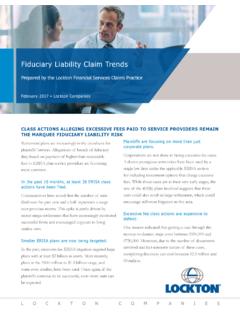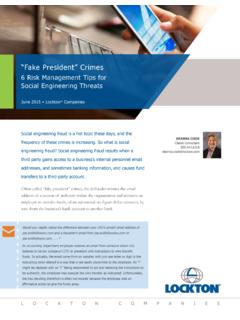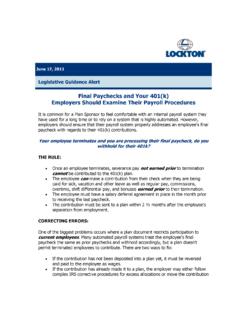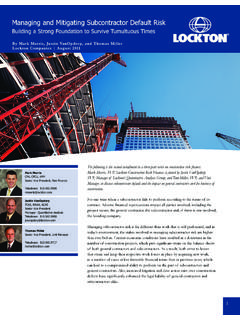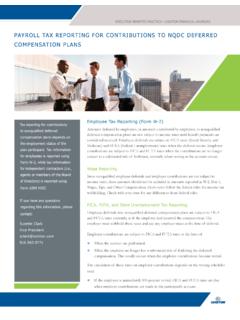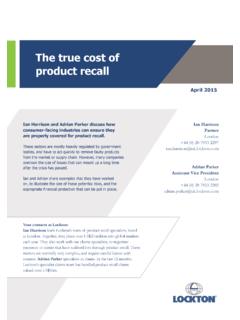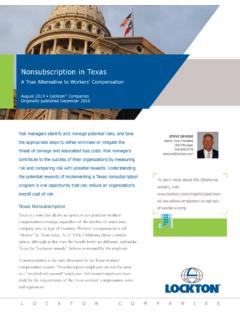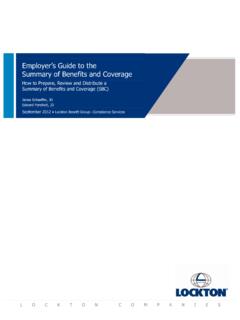Transcription of Employment Practices Liability Claim Trends
1 Employment Practices Liability Claim TrendsPrepared by the Lockton Financial Services Claims PracticeNovember 2017 Lockton CompaniesLOCKTON COMPANIESREGULATORS EASE BURDENS ON EMPLOYERS BY RESCINDING RECENT REGULATORY EXPANSIONU nder the Obama administration, the US Department of Labor (DOL) and the Equal Employment Opportunity Commission (EEOC) expanded regulatory compliance burdens for employers. Fortunately for employers, the most controversial expansions have been curtailed or delayed by the current administration. Examples include: In 2016, the DOL sought to increase the number of workers eligible for overtime by more than doubling the salary threshold to $47,476. In December 2016, a district court in Texas temporarily enjoined the implementation of the new overtime rules, and since then, the DOL has reopened the public comment process and sought stakeholder feedback about the salary level and other related issues.
2 While the DOL has shown no hurry to implement new overtime rules, the same Texas court recently held the new rules invalid, ensuring that the familiar overtime regulations will apply for the foreseeable future. The DOL has retracted other recent guidance unfavorable to employers: hThe DOL retracted joint employer guidance that expanded potential Liability for franchisors, staffing agencies, and others using nontraditional employer-employee relationships. hThe DOL rescinded guidance critical of employers that classified workers as independent contractors when they are actually employees. 2 November 2017 Lockton Companies hThe DOL has taken steps to rescind the persuader rule, which required employers to report about their use of consultants, including lawyers, as a means of persuading employees concerning collective bargaining activities.
3 The rule had already been blocked by a Texas district court. hThe DOL reinstated the practice of issuing opinion letters, halted since 2010, in an effort to provide a clearer understanding of the Fair Labor Standards Act (FLSA) and other statutes. Experts considered this a sign of a more conciliatory DOL that will be less enforcement-focused and more interested in clarifying complex wage and hour rules. The current administration has stopped the EEOC s plan to begin collecting wage and payment data from employers via the EEO-1 form. The data was to be collected to combat pay discrimination, but critics said it would not achieve that goal and imposed an enormous compliance burden.
4 If the new rule had gone into effect, it would have likely led to a rash of new pay discrimination claims from the EEOC and the plaintiff s bar. In 2016, the EEOC issued final rules concerning employer-sponsored voluntary health programs that incentivize employees with lower premiums if they make healthier lifestyle choices. The new rules said incentive payments transmuted the voluntary health programs into involuntary ones that ran afoul of the Americans with Disabilities Act (ADA) and the Genetic Information Nondiscrimination Act (GINA). The new rules created compliance uncertainty and increased risk of EEOC enforcement actions. In AARP v. EEOC, however, a district court ordered the EEOC to review the rules and justify more strongly why incentives made the programs involuntary.
5 Different EEOC commissioners are likely to review the rules than the ones who initially approved them and experts expect employer-friendly changes to the rules. Not all regulatory news is pro-employer; several states and cities have prohibited asking job applicants about salary history. Such rules created by New York City, Delaware, and Massachusetts are set to take effect at the end of October, December, and January, respectively. These rules are designed to combat historical pay disparities by not perpetuating existing pay differences, but they add another compliance hurdle for employers and potential grounds for Employment 2017 Lockton CompaniesPOTENTIAL SEA CHANGE IN SEXUAL HARASSMENT CLAIMS AFTER HIGH-PROFILE SCANDALSThe past year has seen unprecedented publicity for sexual harassment claims involving many high profile industries, companies, and individual defendants.
6 The Harvey Weinstein scandal has upped the ante further, and along with high profile gender-based equal pay claims, are likely to embolden the plaintiffs bar and potentially could increase the frequency and severity of such matters. EPL policies typically cover equal pay and sexual harassment claims, but some insurers have taken positions that sexual contact and assaults are not covered. If sexual harassment claims increase, more insurers may take this adversarial position or amend policy COURT TO RULE ON ENFORCEABILITY OF CLASS ACTION WAIVERS IN Employment AGREEMENTSOn October 2, 2017, the Supreme Court heard oral arguments concerning the legality of class action waivers in Employment contracts under the National Labor Relations Act (NLRA).
7 The Seventh and Ninth Circuits ruled that the NLRA prohibited such waivers because of workers rights to engage in concerted activities, but the Fifth Circuit ruled otherwise, and now all three decisions have been consolidated before the Supreme Court. A decision is expected by the end of the court s current term in June , a New York appellate court has recently ruled that class action waivers are unenforceable under the NLRA. That ruling would likely be reversed if the Supreme Court rules approved by the Supreme Court, employers may use class action waivers to force single plaintiff arbitrations and potentially avoid costly wage and hour class COURT TO RULE ON SCOPE OF WHISTLEBLOWER PROTECTIONS IN DODD-FRANKThe Supreme Court has also agreed to resolve the circuit court split concerning the scope of whistleblower protections under Dodd-Frank.
8 Dodd-Frank protects whistleblowers from retaliation when reporting alleged misconduct to the SEC, but the statute is unclear if the same anti-retaliation protections apply when reporting misconduct internally. Most EPL insurance policies define retaliation broadly and should cover employers under both 2017 Lockton CompaniesCOURT RULES THAT FEDERAL LAW DOES NOT PREEMPT STATE S MEDICAL MARIJUANA LAW AND EMPLOYEE IS PROTECTED AGAINST DISCRIMINATIONA Connecticut court ruled that federal laws criminalizing marijuana use did not preempt state law and that a job applicant could bring a private right of action for discrimination under state law. The court held that federal criminal statutes neither make it illegal to employ a marijuana user nor regulate Employment Practices .
9 Moreover, while the ADA allows employers to prohibit illegal drug use in the work place, it does not authorize adverse Employment action for drug use outside the workplace. A Massachusetts court reached a similar conclusion. These decisions are not controlling, but offer an early indication of how courts may treat marijuana-based Employment SINCE SUPREME COURT S RULING IN SPOKEO HAVE LARGELY FAVORED PLAINTIFFSIn 2016, the Supreme Court ruled in Spokeo that a bare procedural violation of the Fair Credit Reporting Act (FCRA) was an insufficient basis for a lawsuit, and that a plaintiff had to allege a concrete injury to bring a suit. The Ninth Circuit recently decided that the allegations in Spokeo the incorrect reporting of the plaintiff s marital status, Employment history, and age were sufficiently concrete to potentially injure his Employment prospects and conveyed standing to bring the lawsuit.
10 The Ninth Circuit rejected arguments that the alleged injuries were too speculative or decision joins several others that found standing for alleged statutory violations based on the potential for future harm. The Third, Sixth, Seventh, Eleventh and Circuits have all issued similar rulings to the Ninth Circuit s. The Second, Fourth, and Eighth Circuits, however, have ruled the opposite, which may return this issue to the Supreme Court for further clarification. Until then, the majority of circuits have made it easier for plaintiffs to bring claims under statutes like the FCRA and the Telephone Consumer Protection Act (TCPA). FCRA claims are up nearly 7 percent in 2017 compared to the same period a year ago.
